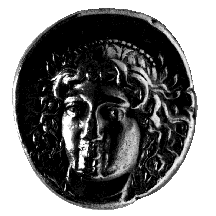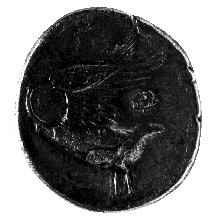



(34) Klazomenai, Ionia (Turkey) - AR tetradrachm, 387-340 B.C.,
16.88 g. (inv. 93.009).
Obverse: Facing head of Apollo.
Reverse: Swan with spread wings l.
Provenance: Ex Perkins collection; Harlan Berk, 1991.
Bibliography: C.M. Kraay, Archaic and Classical Greek Coins (Berkeley
and Los Angeles 1976) 257-258.
Klazomenai in Ionia on the western coast of Asia Minor was one of the first
cities to issue silver coinage. The city was originally located on the mainland,
but probably during the early fifth-century Ionian Revolt from the Persians
it was moved to an island just off the coast, which Alexander the Great
eventually connected to the mainland with a causeway. In 387 B.C. Klazomenai
and other cities in Asia were taken over by Persia, but the city continued
to issue its own coins.
The obverse of this tetradrachm depicts the principal god of the city, Apollo.
The near-facing
head was influenced by Kimon's facing head of the nymph Arethusa on Syracusan
coins of the late fifth century (see no. 17); the
Klazomenian head has a similar fleshy face, large eyes and wild hair.
The swan on the obverse is both an attribute of Apollo and a pun on the
name Klazomenai. According to myth, swans drew the chariot in which Apollo
every year flew south from his winter home in the land of the Hyperboreans.
But Klazomenai was also home to large numbers of swans, and it is thought
that the verb klazo was used to describe the call of the wild birds.
C.L.L.



All contents copyright (c) 1996.
Lawrence University
All rights reserved.